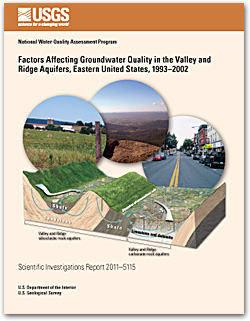Skip Links
Scientific Investigations Report 2011–5115
National Water-Quality Assessment Program
Factors Affecting Groundwater Quality in the Valley and Ridge Aquifers, Eastern United States, 1993–2002
By Gregory C. Johnson, Tammy M. Zimmerman, Bruce D. Lindsey, and Eliza L. Gross
 Abstract Abstract
Chemical and microbiological analyses of water from 230 wells and 35 springs in the Valley and Ridge Physiographic Province, sampled between 1993 and 2002, indicated that bedrock type (carbonate or siliciclastic rock) and land use were dominant factors influencing groundwater quality across a region extending from northwestern Georgia to New Jersey. The analyses included naturally occurring compounds (major mineral ions and radon) and anthropogenic contaminants [pesticides and volatile organic compounds (VOCs)], and contaminants, such as nitrate and bacteria, which commonly increase as a result of human activities. Natural factors, such as topographic position and the mineral composition of underlying geology, act to produce basic physical and geochemical conditions in groundwater that are reflected in physical properties, such as pH, temperature, specific conductance, and alkalinity, and in chemical concentrations of dissolved oxygen, radon, and major mineral ions. Anthropogenic contaminants were most commonly found in water from wells and springs in carbonate-rock aquifers. Nitrate concentrations exceeded U.S. Environmental Protection Agency maximum contaminant levels in 12 percent of samples, most of which were from carbonate-rock aquifers. Escherichia coli (E. coli), pesticide, and VOC detection frequencies were significantly higher in samples from sites in carbonate-rock aquifers. Naturally occurring elements, such as radon, iron, and manganese, were found in higher concentrations in siliciclastic-rock aquifers. Radon levels exceeded the proposed maximum contaminant level of 300 picocuries per liter in 74 percent of the samples, which were evenly distributed between carbonate- and siliciclastic-rock aquifers. The land use in areas surrounding wells and springs was another significant explanatory variable for the occurrence of anthropogenic compounds. Nitrate and pesticide concentrations were highest in samples collected from sites in agricultural areas and lowest in samples collected from sites in undeveloped areas. Volatile organic compounds were detected most frequently and in highest concentrations in samples from sites in urban areas, and least frequently in agricultural and undeveloped areas. No volatile organic compound concentrations and concentrations from only one pesticide, dieldrin, exceeded human-health benchmarks.
|
Part or all of this report is presented in Portable Document Format (PDF); the latest version of Adobe Reader or similar software is required to view it. Download the latest version of Adobe Reader, free of charge. |
Suggested citation:
Johnson, G.C., Zimmerman, T.M., Lindsey, B.D., and Gross, E.L., 2011, Factors affecting groundwater quality in the Valley and Ridge aquifers, eastern United States, 1993-2002: U.S. Geological Survey Scientific Investigations Report 2011-5115, 70 p.
Contents
Foreword
Abstract
Introduction
Purpose and Scope
Previous Studies
Study Area
Physiography
Climate
Land Use and Population
Hydrogeology
Water Availability and Use
Data Sources and Methods
Well and Spring Networks
Water-Quality Sampling and Analysis
Quality-Assurance Methods
Human-Health Benchmarks
Statistical Methods
Geographic Information System Methods and Topographic Variables
Groundwater Quality in the Valley and Ridge Aquifers
Basic Groundwater Properties and Chemical Composition
Residence Time, Oxygen, and Chemical Equilibria
Water Quality in Relation to Land Use and Topography
Selected Contaminants in Groundwater from the Valley and Ridge Aquifers and the Factors that Affect Their Occurrence
Nitrate
Occurrence and Distribution of Nitrate
Factors Affecting Nitrate Concentrations
Pesticides
Occurrence and Distribution of Pesticides
Assessment of Potential Effects of Pesticides on Human Health
Factors Affecting Occurrence of Frequently Detected Pesticides
Other Pesticides Analyzed
Volatile Organic Compounds
Occurrence and Distribution of VOCs
Assessment of Potential Effects of VOCs on Human Health
Factors Affecting Occurrence of VOCs
Fecal-Indicator Bacteria
Occurrence and Distribution of Fecal-Indicator Bacteria
Factors Affecting Occurrence of Fecal-Indicator Bacteria
Radon
Occurrence and Distribution of Radon
Factors Affecting Concentrations of Radon
Distribution of Sites with Background Concentration and Sites with Evidence of Anthropogenic Contamination
Summary and Conclusions
Acknowledgments
References Cited